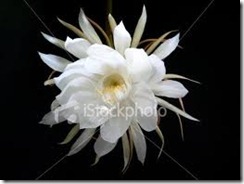Two genus possess the common name of night-blooming cereus: hylocereus and selenicereus, according to The University of Arkansas Division of Agriculture. Members of the cactus family, these two genus are similar in flowering and growth patterns. These plants are often cultivated in home gardens for their seen-only-in-the-evening blooms rather than their foliage.
-
Plant Characteristics
Of the two genus, the hylocereus is more predominantly seen than the selenicereus genus. The hylocereus genus is native to the tropics. The stems of this night-blooming cereus are slender, three-ribbed and light green to yellow green in color. Possessing sparse, short spines, the hylocereus night-blooming cereus plant is classified as a hanging plant or a climber. Originally from the Caribbean Islands, the slender stems of the selenicereus genus grow quickly and are cylindrical in shape. The green stems change color to purple as they mature. The selenicereus genus is also known as the Queen of the Night.
-
Flower Characteristics
Buds form along the stems of the night-blooming cereus and open only at night. The flowers are shaped like a funnel and measure a foot or more in width. Blooms are a creamy-white color, and waxy in texture with a number of petals. Short-spined, egg-shaped fruit that are red-orange in color appear after the blooms are done. Flowers generally appear on plants that are two to three years old and sometimes bloom in alternating years. Annual blooms can be forced by reducing watering and fertilization during fall and winter months. Allow the soil to dry between waterings and place the plant in an isolated spot where it can still receive filtered light. Root-bound plants bloom more often, so do not be inclined to repot the night-blooming cereus.
-
Habitat
The night-blooming cereus is basically a houseplant that may be moved outdoors during warm, humid months. It prefers indirect light, so place it in an area where there is filtered light. A low-maintenance plant, it prefers organic matter soil types that are well aerated, such as a sandy mix. Although the night-blooming cereus thrives in tropical conditions, avoid over-watering it as too much water will cause root rot and potential death. The cereus plant roots well so propagation is best done from a cutting.


Deprecated: strpos(): Passing null to parameter #1 ($haystack) of type string is deprecated in /home/agriviek8Qv/agriviet.net/public_html/wp-includes/comment-template.php on line 2522